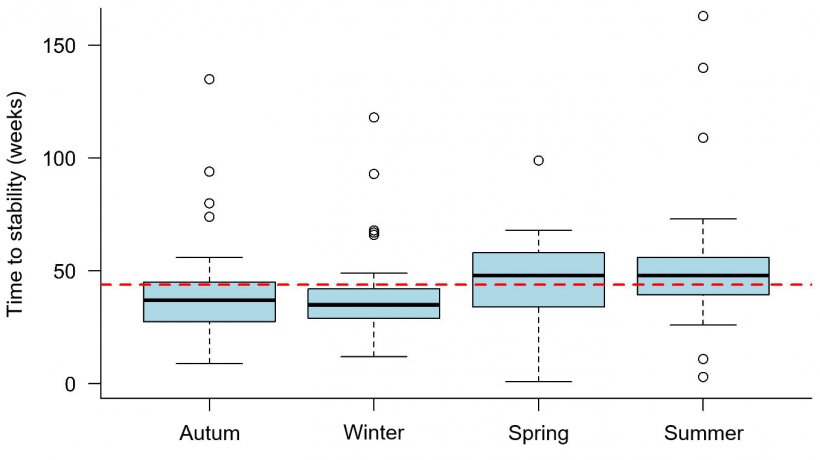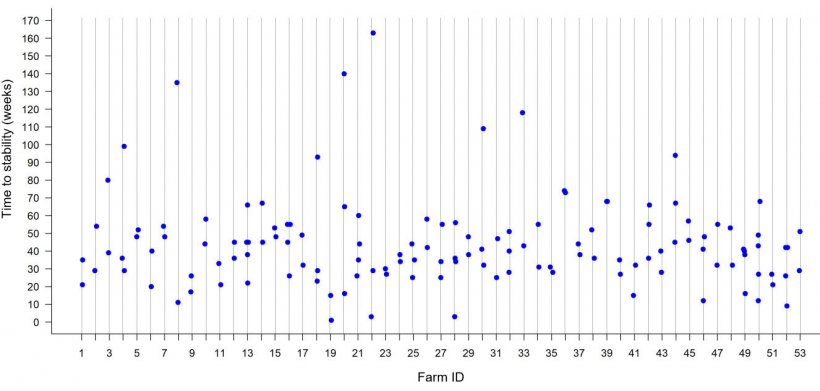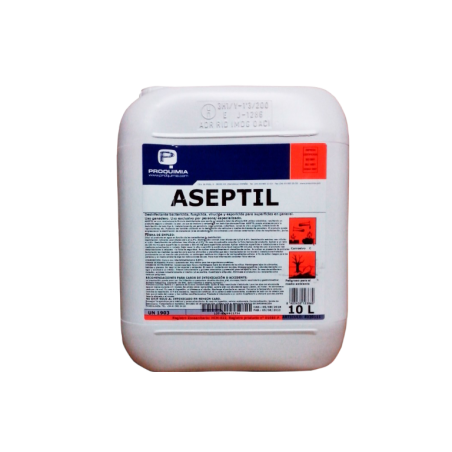Time-to-stability
Time-to-stability (TTS) is the time required for a herd to wean porcine reproductive and respiratory syndrome (PRRS) virus PCR negative piglets after an outbreak. TTS is an important measure for quantifying the duration of shedding, planning herd closure length, and evaluating the interventions used in the breeding herd. An effort to standardize the classification criteria and testing strategy was made by Holtkamp et al. (2011) who suggested four consecutive negative PCR results in 30 due-to-wean piglets, 30 days apart for moving a herd into the positive stable category. It is important to highlight that stability does not mean negativity. The concept of stability acknowledges that the virus may still be present at low levels in the herd, despite being undetectable using the suggested testing strategy in wean-age piglets.

What factors can affect time-to-stability?
Linhares et al. (2014) observed that herds that used live virus inoculation (LVI) in the face of an outbreak to homogenize the herd reached stability about seven weeks sooner than herds that used modified live vaccine. Additionally, herds that had a prior PRRS outbreak reached stability about three weeks sooner than herds without a history of PRRS.
The virus can be classified using three numbers that are defined by the position where three enzymes cut the PRRS virus genome. This nomenclature is known as restriction fragment length polymorphism (RFLP) pattern. After the emergence of the 1-7-4 RFLP pattern in 2014 in the US, anecdotal reports suggested an increased TTS in herds having 1-7-4 outbreaks. Recently, our group observed that 1-7-4 outbreaks had a longer TTS than outbreaks with other RFLP patterns (Sanhueza et al., 2018), which agrees with a previous observation (Linhares et al., 2017). Notably, PRRS outbreaks that occurred during spring/summer had a significantly longer TTS than outbreaks occurring during autumn/winter (Figure 1).

Although TTS can vary significantly among production companies (Linhares et al., 2014), it can also vary between farms in a company, and between outbreaks in the same farm. However, scarce information exists on the magnitude and relative importance of these sources of variation.
Do outbreaks in the same farm have a similar time-to-stability?
To answer this question we worked with six companies located in the Midwestern United States. These companies are similar in the way they test to classify a herd as stable for PRRS virus and guided by the Holtkamp et al. (2011) terminology. PRRS outbreaks reported between 2011 and 2017 were used to calculate TTS. In order to compare the TTS within the same farm, only those farms that had at least two PRRS outbreaks were selected for this analysis.
Overall, 53 farms that reported 133 outbreaks were included in the study where the majority of farms (n=35) reported two outbreaks. Eleven farms reported three outbreaks, five farms reported four outbreaks, and two farms reported five outbreaks. LVI was the outbreak intervention used for whole herd exposure in most outbreaks (110/117 outbreaks with information on intervention). The overall TTS mean was 43.9 weeks (last negative PCR test).
Figure 2 shows TTS of PRRS outbreaks observed in the 53 farms. Mean TTS difference between outbreaks within the same farm was 25.7 weeks with a range between 0 weeks and 160 weeks. Although we accounted for the effect of several factors that can affect TTS (i.e. season of the year, RFLP pattern, year of the outbreak, previous PRRS history, and the intervention used to homogenize the herd), still most of the TTS variation occurred between outbreaks in the same farm. In other words, the TTS of two given outbreaks in the same farm at different time points was largely dissimilar (Figure 2) and such difference may be attributed to farm specific intrinsic factors. TTS differences between companies had a small impact on TTS variability.

What other factors could explain time-to-stability differences of two or more outbreaks in the same farm?
Even though viral characteristics (e.g. RFLP pattern), outbreak intervention implemented, the season of the year when the outbreak occurred, and company can influence TTS, still two PRRS outbreaks within the same farm can have largely different TTS. Thus, the same farm can have outbreaks with short and long TTS, which explains the frustration of producers and practitioners when working towards stability. These results suggest that other unmeasured factors associated with each individual outbreak (e.g. outbreak management, season of the outbreak, farm manager/workers experience or training, control measures implemented, and internal biosecurity) are likely to have a greater impact on TTS and may help further explaining the large TTS difference of two outbreaks within the same farm.









